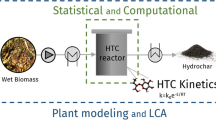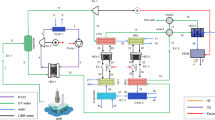Abstract
We present a novel coupled organic Rankine cycle (CORC) system driven by the low-grade waste heat, which couples a transcritical organic Rankine cycle with a subcritical organic Rankine cycle. Based on classical thermodynamic theory, a detailed performance analysis on the novel CORC system was performed. The results show that the pressure ratio of the expander is decreased in the CORC and the selection of the working fluids becomes more flexible and abundant. With the increase of the pinch point temperature difference of the internal heat exchanger, the net power output and thermal efficiency of the CORC all decrease. With the increase of the critical temperature of the working fluid, the system performance of the CORC is improved. The net power output and thermal efficiency of the CORC with isentropic working fluids are higher than those with dry working fluids.
Similar content being viewed by others
References
D. H. Wei, X. S. Lu, Z. Lu and J. M. Gu, Performance analysis and optimization of organic Rankine cycle (ORC) for waste heat recovery, Energy Conversion and Management, 48 (4) (2007) 1113–1119.
H. J. Chen, D. Y. Goswami and E. K. Stefanakos, A review of thermodynamic cycles and working fluids for the conversion of low-grade heat, Renewable and Sustainable Energy Reviews, 14 (2010) 3059–3067.
J. Guo, M. Xu and L. Cheng, Thermodynamic analysis of waste heat power generation system, Energy, 35 (7) (2010) 2824–2835.
D. Wang, X. Ling, H. Peng, L. Liu and L. Tao, Efficiency and optimal performance evaluation of organic Rankine cycle for low grade waste heat power generation, Energy, 50 (2013) 343–352.
Z. Q. Wang, N. J. Zhou, J. Guo and X. Y. Wang, Fluid selection and parametric optimization of organic Rankine cycle using low temperature waste heat, Energy, 40 (1) (2012) 107–115.
S. Quoilin, S. Declaye, B. F. Tchanche and V. Lemort, Thermo-economic optimization of waste heat recovery organic Rankine cycles, Applied Thermal Engineering, 31 (14) (2011) 2885–2893.
Q. C. Chen, J. L. Xu and H. X. Chen, A new design method for organic Rankine cycles with constraint of inlet and outlet heat carrier fluid temperatures coupling with the heat source, Applied Energy, 98 (2012) 562–573.
A. Borsukiewicz-Gozdur, Exergy analysis for maximizing power of organic Rankine cycle power plant driven by open type energy source, Energy, 62 (2013) 73–81.
S. L. Milora and J. W. Tester, Geothermal energy as a source of electric power: Thermodynamic and economic design criteria, NASA STI/Recon Technical Report A, 77 (1976) 16623.
G. L. Mines, Test plan for heat cycle research program, Phase I Supercritical Cycle Tests, USDOE Office of Energy Efficiency and Renewable Energy Geothermal Technology Program (1983).
K. Gawlik and V. Hassani, Advanced binary cycles: Optimum working fluids, Proceedings of the 32nd Intersociety of Energy Conversion Engineering Conference, 3 (1997) 1809–1814.
A. Algieri and P. Morrone, Comparative energetic analysis of high-temperature subcritical and transcritical organic Rankine cycle (ORC), A biomass application in the Sibari district, Applied Thermal Engineering, 36 (2012) 236–244.
S. J. Zhang, H. X. Wang and T. Guo, Performance comparison and parametric optimization of subcritical organic Rankine cycle (ORC) and transcritical power cycle system for low-temperature geothermal power generation, Applied Energy, 88 (8) (2011) 2740–2754.
D. Mikielewicz and J. Mikielewicz, A thermodynamic criterion for selection of working fluid for subcritical and supercritical domestic micro CHP, Applied Thermal Engineering, 30 (16) (2010) 2357–2362.
N. A. Lai, M. Wendland and J. Fischer, Working fluids for high-temperature organic Rankine cycles, Energy, 36 (1) (2011) 199–211.
G. Q. Qiu, H. Liu and S. Riffat, Expanders for micro- CHP systems with organic Rankine cycle, Applied Thermal Engineering, 31 (16) (2011) 3301–3307.
J. Bao and L. Zhao, A review of working fluid and expander selections for organic Rankine cycle, Renewable and Sustainable Energy Reviews, 24 (2013) 325–342.
H. G. Zhang, H. Liang, X. Liu, B. Liu, Y. Chen, Y. T. Wu, W. Wang and K. Yang, Research of two stage single screw expander organic Rankine cycle system scheme based on the waste heat recovery of diesel engine’s exhaust gas, Advanced Materials Research, 201 (2011) 600–6005.
D. W. Hanner, J. L. McElroy, E. Robinson and W. M. Wells, High-temperature testing and evaluation of graphite helical-screw expanders and compressors, J. of Spacecraft and Rockets, 4 (6) (1967) 761–767.
D. W. Taitt, C. P. Garner, E. Swain, D. Blundell, R. J. Pearson and J. W. G. Turner, An automotive engine charge-air intake conditioner system: analysis of fuel economy benefits in a gasoline engine application, Proceedings of the Institution of Mechanical Engineers, Part D: J. of Automobile Engineering, 220 (9) (2006) 1293–1307.
E. H. Wang, H. G. Zhang, B. Y. Fan, M. G. Ouyang, Y. Zhao and Q. H. Mu, Study of working fluid selection of organic Rankine cycle (ORC) for engine waste heat recovery, Energy, 36 (5) (2011) 3406–3418.
H. G. Zhang, E. H. Wang, M. G. Ouyang and B. Y. Fan, Study of parameters optimization of organic Rankine cycle (ORC) for engine waste heat recovery, Advanced Materials Research, 201 (2011) 585–589.
E. H. Wang, H. G. Zhang, Y. Zhao, B. Y. Fan, Y. T. Wu and Q. H. Mu, Performance analysis of a novel system combining a dual loop organic Rankine cycle (ORC) with a gasoline engine, Energy, 43 (1) (2012) 385–395.
D. Meinel, C. Wieland and H. Spliethoff, Effect and comparison of different working fluids on a two-stage organic rankine cycle (ORC) concept, Applied Thermal Engineering, 63 (1) (2014) 246–253.
J. L. Xu and C. Liu, Effect of the critical temperature of organic fluids on supercritical pressure organic Rankine cycles, Energy, 63 (2013) 109–122.
REFPROP Version 8.0, NIST standard reference database 23 (2007).
J. M. Calm and G. C. Hourahan, Refrigerant data update, HPAC Engineering, 1 (2007) 50–64.
E. Cayer, N. Galanis and H. Nesreddine, Parametric study and optimization of a transcritical power cycle using a low temperature source, Applied Energy, 87 (4) (2010) 1349–1357.
Y. H. Song, J. F. Wang, Y. P. Dai and E. M. Zhou, Thermodynamic analysis of a transcritical CO2 power cycle driven by solar energy with liquified natural gas as its heat sink, Applied Energy, 92 (2012) 194–203.
T. Guo, H. X. Wang and S. J. Zhang, Comparative analysis of CO2-based transcritical Rankine cycle and HFC245fa-based subcritical organic Rankine cycle using low-tempera-ture geothermal source, Science China Technological Sciences, 53 (6) (2010) 1638–1646.
F. Vélez, J. Segovia, F. Chejne, G. Antolin, A. Quijano and M. C. Martin, Low temperature heat source for power generation: Exhaustive analysis of a carbon dioxide transcritical power cycle, Energy, 36 (9) (2011) 5497–507.
T. Guo, H. X. Wang and S. J. Zhang, Comparative analysis of natural and conventional working fluids for use in transcritical Rankine cycle using low-temperature geothermal source, International J. of Energy Research, 35 (6) (2011) 530–544.
Y. J. Baik, M. Kim, K. C. Chang and S. J. Kim, Powerbased performance comparison between carbon dioxide and R125 transcritical cycles for a low-grade heat source, Applied Energy, 88 (3) (2011) 892–898.
Y. Chen, P. Lundqvist, A. Johansson and P. Platell, A comparative study of the carbon dioxide transcritical power cycle compared with an organic Rankine cycle with R123 as working fluid in waste heat recovery, Applied Thermal Engineering, 26 (17) (2006) 2142–2147.
Z. Gu and H. Sato, Performance of supercritical cycles for geothermal binary design, Energy Conversion and Management, 43 (7) (2002) 961–971.
K. C. Ng, T. B. Lim and T. Y. Bong, Analysis of screwexpander performance, Proceedings of the Institution of mechanical engineers, Part E: J. of Process Mechanical Engineering, 203 (1) (1989) 15–20.
S. Clemente, D. Micheli, M. Reini and R. Taccani, Performance analysis and modeling of different volumetric expanders for small-scale organic Rankine cycles, ASME 2011 5th International Conference on Energy Sustainability, American Society of Mechanical Engineers (2011) 375–384.
S. Declaye, S. Quoilin, L. Guillaume and V. Lemort, Experimental study on an open-drive scroll expander integrated into an ORC (organic Rankine cycle) system with R245fa as working fluid, Energy, 55 (2013) 173–183.
A. Schuster, S. Karellas and R. Aumann, Efficiency optimization potential in supercritical organic Rankine cycles, Energy, 35 (2) (2010) 1033–1039.
Author information
Authors and Affiliations
Corresponding author
Additional information
Recommended by Associate Editor Tong Seop Kim
Xi-Wu Gong received his M.S. from Anhui University of Science & Technology, Huainan, China, in 1996, obtained his Ph.D. in Engineering Thermophysics from Shanghai Jiaotong University in 2008. He is an associate professor at Zhejiang Ocean University. His major interests are heat transfer, thermodynamics, energy conversion and saving.
You-Rong Li received his Ph.D. from the College of Power Engineering, Chongqing University, Chongqing, China, in 1999, and worked as a Postdoctoral Fellow in Institute of Advanced Material Study, Kyushu University, Japan, during 2000- 2002. He is a professor at Chongqing University. His major interests are engineering thermodynamics, convective heat transfer, thermocapillary flow and stability.
Rights and permissions
About this article
Cite this article
Gong, XW., Wang, XQ., Li, YR. et al. Thermodynamic performance analysis of a coupled transcritical and subcritical organic Rankine cycle system for waste heat recovery. J Mech Sci Technol 29, 3017–3029 (2015). https://doi.org/10.1007/s12206-015-0632-x
Received:
Revised:
Accepted:
Published:
Issue Date:
DOI: https://doi.org/10.1007/s12206-015-0632-x




